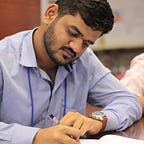Innovation at it’s peak, when Computer Vision meets Visual Assistive Technology
Mr. Brandon Gilles, Founder, OpenCV AI Kit (OAK) talked about the business applications of the kit on Innovator Meetups Episode 2.
Artificial intelligence not only makes our lives easier by automating worldly and time-consuming tasks, it also opens up a myriad of possibilities for people with disabilities and promising unique ways to experience the world. Thanks to AI-powered innovations, the assistive technology industry has progressed far beyond wheelchairs, prosthetic or vision and hearing aids.
For example, AI-powered technology can give voice to non-verbal people: the BrightSign Glove is a machine-based learning device that converts sign language into speech; empowers sign-holders with the ability to interact freely with the world.
The functioning of our physical environment assumes that we have the ability to see. Small day-to-day activities, such as reading menus at restaurants, locating toilets, reading instructions on how to prepare a prepared meal, or simply looking in the mirror to see if their clothes fit, are among the daily challenges that blind people face when navigating their physical environment. Vision and language models can help blind people resolve these difficulties, primarily through Visual Question Answering (VQA), which allows blind people to take pictures of things, ask questions about these images, and get timely spoken responses.
At Innovator Meetups Episode 2, Brandon cited many of applications of OAK, the cameras along with the onboard chips can perform a number of computer vision tasks such as detecting objects, counting people, finding distances between things in the frame, and more.
Innovation is crucially different from invention, because it is the turning of inventions into things of practical and affordable use to people. It speeds up in some sectors and slows down in others. It is always a collective, collaborative phenomenon, involving trial and error, not a matter of lonely genius.
— Mr. Brandon (founder OAK) quoted from book ‘How Innovation Works’.
OpenCV says that OAK can find application in a huge variety of products to add computer vision capabilities, including for robotics and drones. Imagine being able to see and process details of objects in the frame just like the T-1 in the movie Terminator. Maybe we have a few more years to build T-1 like robots but this is definitely a start.
It can be used in drones that fly over fields and orchards to determine whether the product is ripe for sale, for monitoring worksites for safety violations, keeping the peace, and guarding the borders of a country and anything else that involves artificial intelligence and computer vision.
Conclusion
I hope you find good information about the details of OpenCV AI Kit (OAK), its applications and business opportunities. All those who wish to dabble in computer vision, want to interact with innovator like Brandon, want to watch the latest business inventions and are interested in joining community are welcomed.
